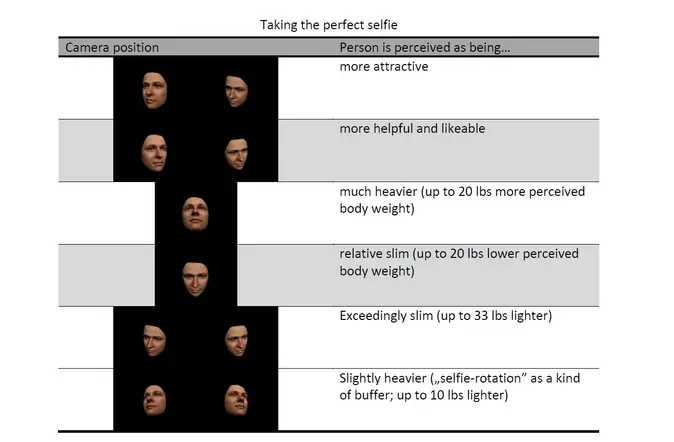Scientists decipher the "perfect selfie"
Taking selfies is now becoming a standard human habit. Celebrities as well as bloggers use them to show off, share their private life, feelings and habits. We get often the impression that they may have a hidden talent to take perfect selfies. However, does science provide any reliable information about how we should take a photo on which we look more attractive, slimmer and more likeable? In a recent study, German psychologists of the University of Bamberg let participants rate serval person-relevant variables (such as attractiveness, dominance, intelligence and body weight) on the basis of faces which were photographed from seven selfie-esque camera positions.
There are many tips and advices how to take the perfect selfie on a large number of websites and blogs. “However, this information is neither scientifically investigated nor really proven. In fact, there is only sparse knowledge about where we have to position a camera to express certain personality related traits such as attractiveness or intelligence”, says Tobias Schneider, one of the authors of the study. Together with professor Claus-Christian Carbon, he recently investigated the impact of camera position on the perception of such variables. “Because selfies provide a common tool in social media, we decided to choose important personality- as well as mating-related variables which play an important role in daily social interactions, for example the perceived attractiveness, dominance, intelligence as well as the body weight”, Schneider further explains.
Accordingly, in an empirical study, the researches presented over 300 participants computer-generated 3D-faces from real persons along seven selfie-esque camera perspectives. The task was, to rate, for example, the perceived attractiveness or body weight. The aim of the study was to investigate whether there are specific camera positions that positively or negatively influence the perception of some of a selfie-taker.
Claus-Christian Carbon states that “the results of the study underline the great impact of the camera position. However, we could also show that there is no ‘perfect selfie’ - in contrast to the common belief that there is just one single preferred camera position. Actually, very much depending on which aspects we want to highlight, a specific camera position has to be chosen.”
Research highlights:
• Showing the left side of the face positively affects the perceived attractiveness, especially for women.
• Showing the right side of the face positively affects the perceived helpfulness, especially for women.
• Showing the right side of the face positively affects the perceived sympathy, especially for men.
• Showing the right side of the face positively affects the perceived intelligence, in general.
• Shooting a selfie from a higher camera position leads to lower body weight judgments (up to 20 lbs). This effect is called “height-weight illusion”.
Most importantly:
The researchers found that we could further lose body weight without dieting or Photoshop editing by just raising the arm with our mobile’s camera and slightly rotating it around the head. Professor Carbon concludes: “The effect of perceived lower body weight is substantially stronger by using this selfie-typical technique. In this case, we are perceived as being more than 30 lbs lighter.”
Open access link:
http://journal.frontiersin.org/article/10.3389/fpsyg.2017.00971/full
Media contact:
Dipl.-Psych. (MSc/Psychology) Tobias Matthias Schneider
Department of General Psychology and Methodology, University of Bamberg
E-Mail: tobias.schneider(at)uni-bamberg.de
Prof. Claus-Christian Carbon, PhD
Department of General Psychology and Methodology, University of Bamberg
E-Mail: ccc(at)uni-bamberg.de
Patricia Achter
PR trainee, University of Bamberg
E-Mail: patricia.achter(at)uni-bamberg.de
